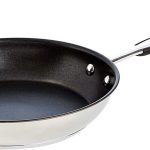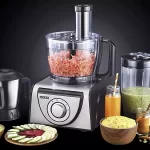How to Store Jicama - The Complete Guide

Jicama is a multifunctional food that is very similar to a vegetable. To clean it, cook it, store it, etc., you must treat it like a vegetable. Jicama is not difficult to work with and is even commonly purchased in the produce section of most grocery stores.
Whether you’re just starting to venture out and try jicama as a staple in your pantry, or you’re a jicama pro who knows the ins and outs and how best to use it in your kitchen, everyone needs a suitable means of storage for their jicama. .
Don’t you hate it when you buy products and don’t get to use them all before you have to throw them away? Or when you find a great deal and stock up and then have no idea what to do with it all?
How do you store the jicama? The most important thing when storing jicama is to keep it dry. Whether you store it on the counter or in the fridge, making sure it stays dry will keep it fresh for much longer.
There are numerous possibilities for properly storing jicama, and that’s why we’re here!
We’ve created a guide to walk you through everything you need to know about jicama storage. We will share with you tips and tricks, and even some that you should not take into account. By the end of our guide, you’ll be a jicama expert.
Read on to learn everything you need to know about jicama, as well as how to store it.
Your guide to jicama - and beyond
The jicama is amazing. It’s like the perfect mix between juicy, sweet and crunchy. It looks a lot like a potato, but its flesh is sweet like an apple. What the heck is jicama?
Jicama is a sweet and crunchy vegetable that comes from Mexico. The part that we commonly use or see is the root, which is tuberous and very similar to a potato in appearance. However, jicama is part of the bean family. Already confused about what jicama is?
We also. But what we do know is that it is a great option and that it can be used for many things. The most common way to eat jicama is raw. Many people like to just munch on raw, peeled jicama . However, it also cooks very well and there are many ways to enjoy it.
Just as there are many ways to use, cook, or serve jicama, there are also many possible ways to store it. While we’ll cover some jicama recipes and cooking ideas, our storage instructions will focus primarily on keeping it raw.
Now, jicama is harvested mainly in Mexico, but it is also common to find it in parts of Asia and the Philippines. You may have also heard jicama referred to as a yam bean.
jicama uses
Jicama can be a versatile vegetable and has many and varied uses. Some of them will be familiar to you, but others may surprise you.
Another thing you should know is that most parts of the jicama are poisonous. Only the root can be consumed. The skin, leaves, or stems that accompany the jicama should be removed and discarded. They are not safe to eat or cook.
Jicama is pretty easy to use. You must wash it, peel it and rinse it again. From there, you can prepare it for whatever use you are going to give it, by cutting it into slices, cubes or even crumbling it.
Here are some ideas and meals that jicama is often used in with great results.
- stir fry
- Salad
- Cabbage salad
- soups
- raw and natural
- Mixed with fruits like apples and oranges
- Mixed with vegetables like onions and carrots
- Chips
- Hash Brown type dishes
- Finely chopped in Pico de Gallo
- make tortillas
- cooking with meats
- Raw and chilled, sprinkled with chili powder, lime and salt
- Raw and cold, served with caramel or sweet dipping sauces and cinnamon
As you can see, the options are almost endless. You can do many different things with jicama. There’s a pretty even mix of things you can do both hot and cold. You can add jicama to almost any dish. It has many health benefits.
jicama storage
Storing jicama is not extremely difficult, but you should know that you have options. When push comes to shove, you may only use small amounts at a time. Or maybe you find a good way to stock up and just need a few storage options to make it last.
You can also try growing your own jicama. You may or may not have great results with it, depending on your climate and your resources, but you can always give it a try. The shelf life of jicama without any measure is limited.
So what are your options?
There is a very important aspect that you must take into account when storing jicama. Regardless of the method you use to store it, you need to be able to keep it dry.
With this in mind, you can store the jicama at room temperature until you cut or peel it. From there, you can store it in the fridge or freezer and it keeps very well. You can even find instructions for canning the jicama if you really want to.
Let’s go over storage methods for the following
- Room temperature storage
- Storage in the refrigerator
- Freezer Storage
We fully trust your ability to do some, all or even a little of each of them.
The good news is that storing jicama is relatively easy.
Store jicama at room temperature
Remember when we said that jicama can be similar to potatoes? Here’s another comparison between the two.
When you buy raw jicama at the store, it comes peeled like a potato. It even looks like a potato. At the time of initial purchase, it is also stored much like a potato .
Here are typical storage recommendations at this time:
- Store unwrapped at room temperature
- Try to store it in a cool and dry place.
- The recommended temperature is between 53 and 59 degrees Fahrenheit, but definitely not colder.
- Make sure they are stored in a place where moisture does not accumulate, as this could lead to rot and mold
If you follow these tips, your potatoes can be stored at room temperature for up to 3 weeks and be fine. You may have to watch them.
The problem is that you have no idea how the jicama was handled before you brought it home. You don’t know the temperatures they faced during processing and distribution, and you don’t know how they were treated.
Choose a jicama that has a tough skin . Aim for glowing, blemish-free skin if possible. These are the ideal jicamas, as they have most likely been treated better, or at least less likely to rot quickly when you bring them home.
Also, look out for jicamas that appear mushy or dull in color and avoid buying them. If possible, you should also avoid jicama with spots, as they are more likely to rot quickly.
When you store your jicamas, treat them with care . You don’t want to move or bang them, as this could bruise or stain the jicama’s protective skin. You certainly don’t want to risk the lifespan of your jicama.
Storing the jicama in the fridge
Once you have cut the jicama, it is safe to store it no longer at room temperature. If you leave it out too long after it’s been cut and peeled, it can start to discolor.
There are lots of fun ways to use jicama that require it to be refrigerated, or that work best when it’s refrigerated. Whether you cut up the jicama to use a few slices or are simply willing to cut it up and save it for other storage, the fridge is another viable short-term storage option.
Here are some tips for fridge storage:
- Pat dry and make sure there is no excess moisture
- Wrap it well (plastic wrap works quite well)
- Store it in the vegetable drawer of the fridge.
- While it is stored in the fridge, try to keep it out of the coldest part of it. The crisper drawer is usually a good place, but make sure it’s not on the side closest to the freezer or near the fan/blower.
Again, the key point here is to make sure your jicamas are stored in a dry place. Wrapping them well prevents them from collecting moisture, which could cause them to become moldy or spoiled.
You should be able to keep your jicama like this in the fridge for about 2 weeks. If you don’t want to use plastic wrap, you can also tightly seal the jicama in a Ziploc-style bag. You just have to make sure it’s well sealed.
Another good way to prevent discoloration is to let them sit in a mixture of water and lemon or lime juice. However, if you do this, remember again that you need them to be DRY when you store them.
Storing jicama in the freezer
Here we come to the ultimate jicama storage solution. Let’s face it, we may not use it that often or only use small amounts. Also, the last time you bought it you stocked up because it was a good deal, and now you have to do SOMETHING with it!
We certainly can’t let those invested dollars go to waste. If you need a storage solution that will last longer than room temperature or time in the fridge, this is the storage solution for you. Trust me, you’ll thank us later for this fabulous option.
Storing jicama in the freezer is super easy . It is as easy to store in the freezer as it is in the fridge.
Do you remember the key point that is extremely important for storage? That’s right, you want it dry for storage.
Here is another thing to know about freezing jicama. You can freeze jicama whole, or you can freeze sliced and diced jicama . Do what suits you at the time you are going to proceed with freezing.
Here are some steps to freeze whole jicama:
- Wrap the whole jicama in aluminum foil. Be sure to wrap it well and cover it enough so that there are no gaps in the product.
- Keep it away from areas of high humidity. It is necessary that it remain dry even in frozen form.
- Store it like this in the freezer for up to 12 months.
Here are some steps for freezing peeled and sliced jicama:
- Dry the jicama slices. Even if they seem dry, you should give them a good pat to trap any excess moisture they may have.
- You can store them in an airtight plastic container or resealable freezer bag. You choose, just make sure it closes tightly in the end.
- Place the jicama in your chosen storage method.
- Seal it well. Don’t neglect this step. Seal those pups!
- Store it like this in the freezer for up to 9 months.
You see it? It is very easy to store jicama. You will never have an excuse for not storing it properly again.
Once your jicama has been frozen, it is very easy to use later. There is no complicated defrosting process that you have to follow.
You can leave the jicama at room temperature for about 30 minutes to an hour and use it immediately, or you can move it to the fridge and thaw overnight.
Keep in mind that once you take them out of the freezer, you will need to use them within a day or two to prevent them from getting soggy.
jicama benefits
Let’s take a brief moment to talk about the benefits of jicama. If you are new to using jicama, you should know how valuable it can be. If you’re already familiar with jicama, you might still find this helpful.
Jicama has a high water content and is ultimately quite nutritious . If you use it as a substitute for potato, that’s great as it cuts down on the carbs and starch you get when you eat potatoes.
Here are some things to know about jicama:
- Low in sugars
- Low in starches
- Low in carbohydrates
- nutritious
- It can be up to 90% water
- Contains a lot of vitamin C
- High fiber content
- Rich in potassium and magnesium
- aids digestion
- Strengthens the immune system
- Maximize brain functions
- Maintains heart health
Related questions
We hope you have found this guide a good resource for all things jicama-related, including storage.
We invite you to consult the questions and answers section for additional information that may be beneficial to you.
Is jicama okay on the keto or low carb diet?
Jicama is a good substitute for carbohydrates in starchy foods that are typically high in them, such as potatoes and water chestnuts. Jicama is considered a healthy carbohydrate and its overall carbohydrate and sugar content is low.
How can I tell if my jicama is bad?
You will most likely know when your jicama has gone bad, but some good indicators to pay attention to are the smell and texture. If it has a rotten or spoiled smell, don’t use it. Also, if the jicama has become slimy or sticky, you should throw it away.











